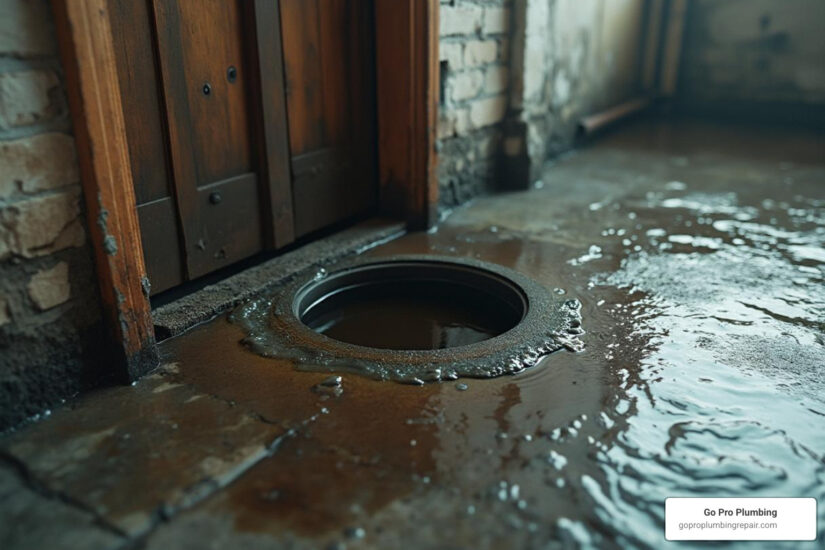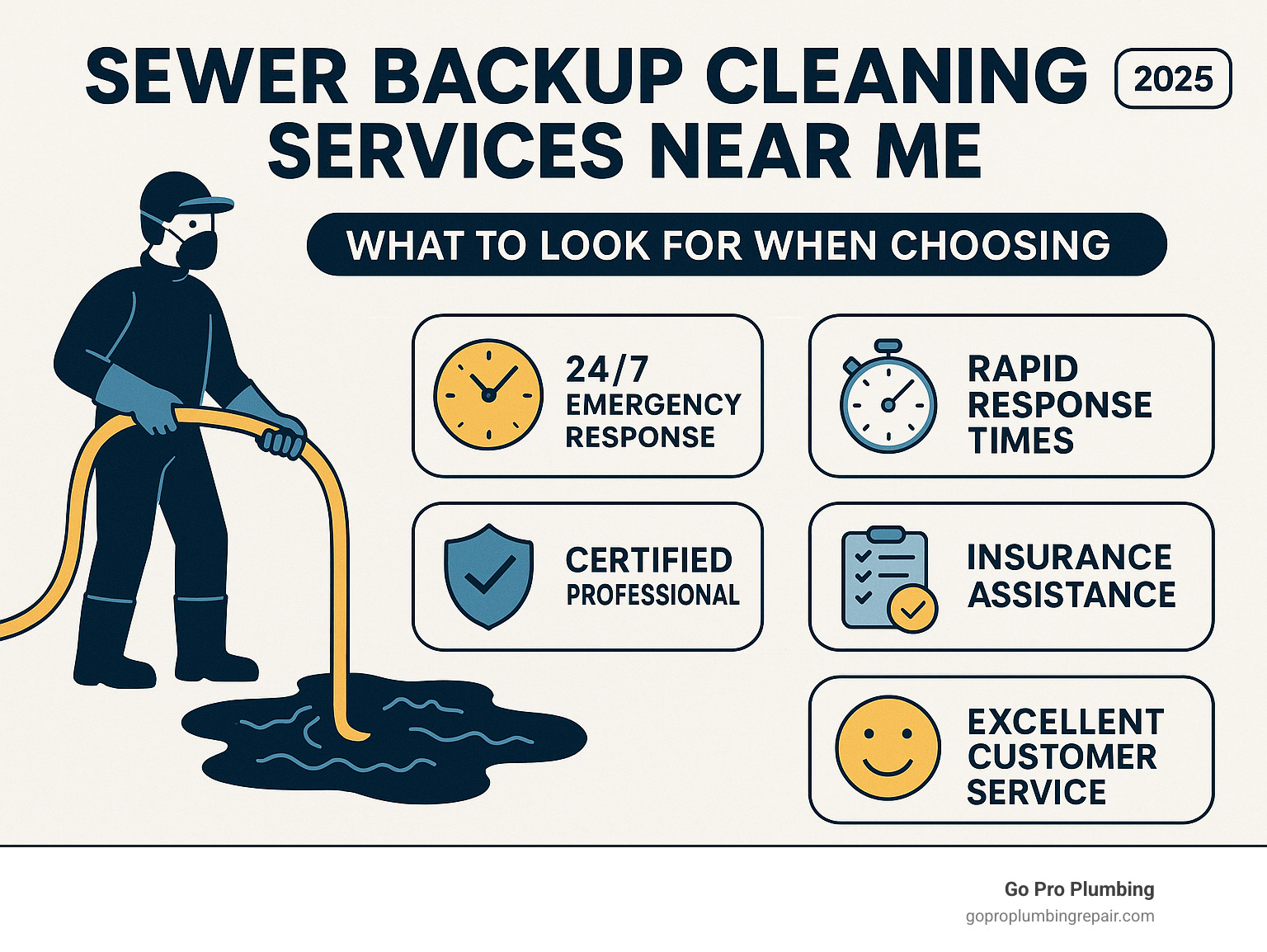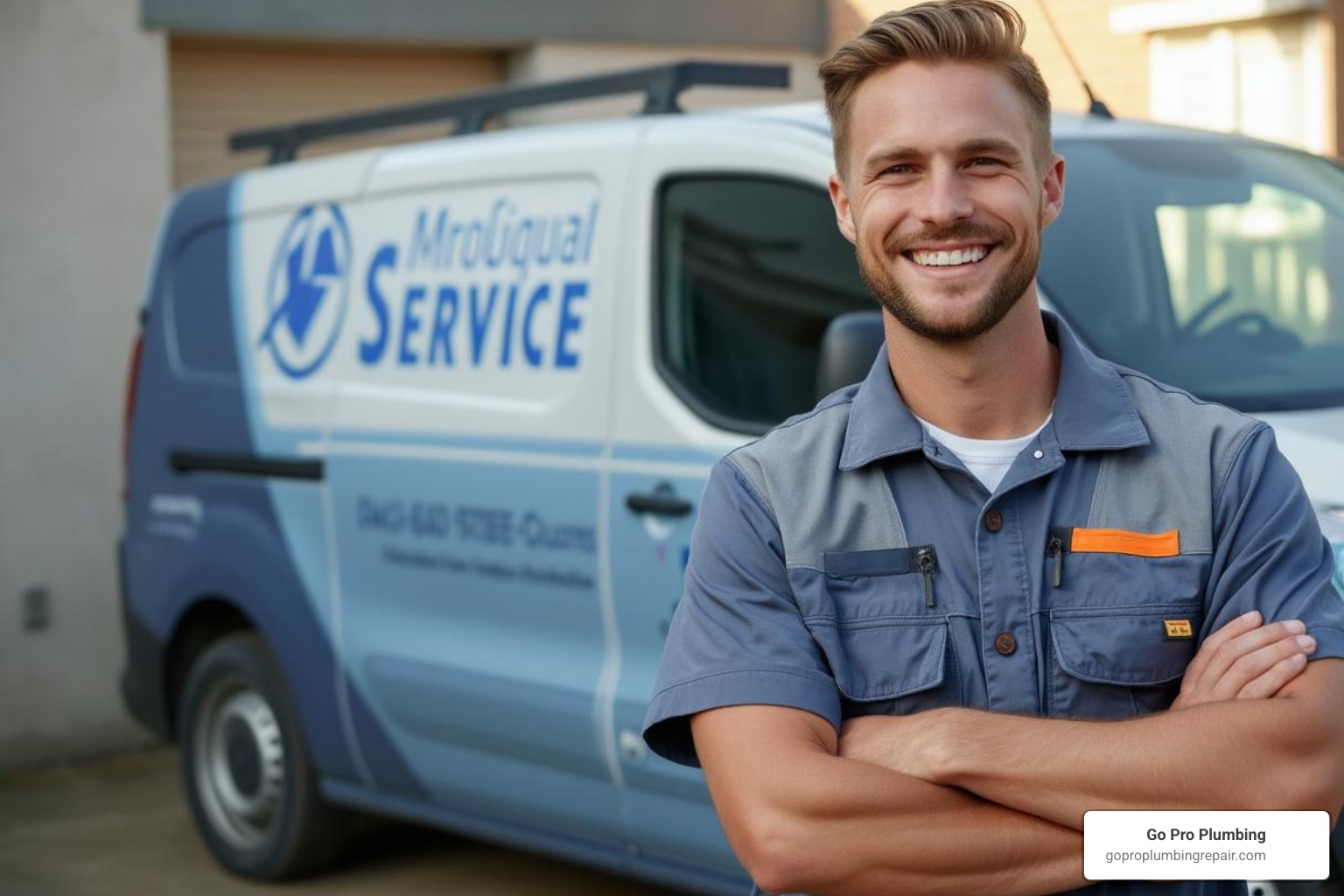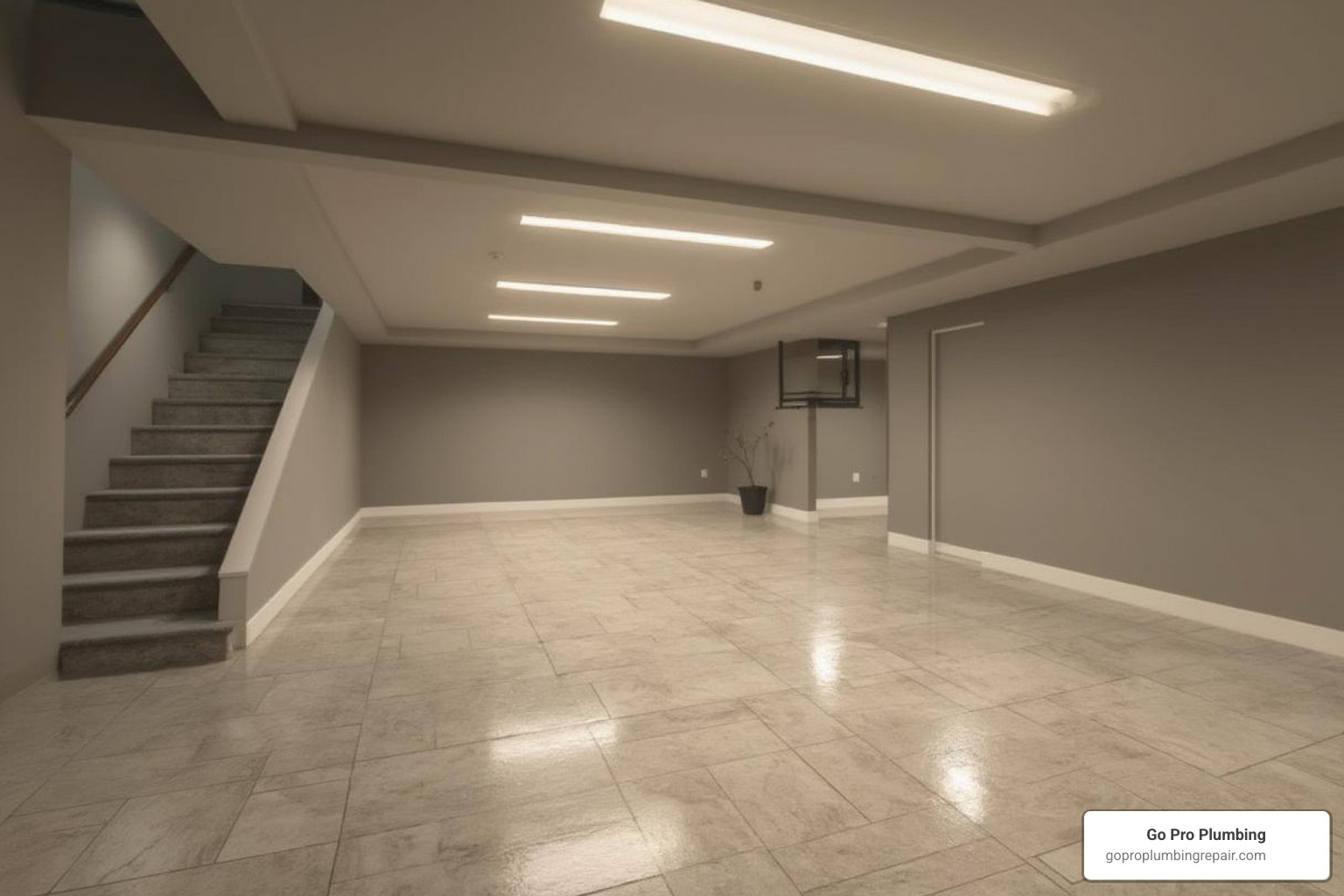Best Sewer Backup Cleaning Services in Your Area
By Brian on July 22, 2025

Finding Top Sewer Backup Cleaning Services Near You
When searching for sewer backup cleaning services near me, you need a fast, reliable team to handle a dangerous biohazard emergency. Look for companies offering 24/7 emergency availability, certified professionals, rapid response times, and direct insurance coordination.
A sewage backup is more than a mess; it’s “black water” filled with harmful bacteria, viruses, and other contaminants that can cause serious illness and widespread property damage. Attempting a DIY cleanup is extremely risky and can worsen the contamination, putting your health at risk. Professional experts with the right training and equipment are essential.
This guide will explain the dangers of sewage backups, show why professional cleanup is non-negotiable, and help you find the best local services to restore your home safely.

Basic sewer backup cleaning services near me terms:
The Dangers of a Sewage Backup: Causes, Health Risks, and Immediate Steps
A sewage backup is a true emergency, releasing contaminated water into your home that threatens your family’s health and your property’s structure. The sight of sewage water flooding your basement or bathroom is a biohazard that requires immediate professional help. For expert service, remember our team at Go Pro Plumbing is ready to help with your Sewer and Drain Emergency Services.
What Causes Sewage Backups?
Sewage backups happen when wastewater can’t leave your home due to a blockage. Common causes include:
- Clogged Pipes: Over time, grease buildup, hair, soap scum, and other debris can create stubborn blockages.
- Tree Root Intrusions: Tree roots seeking water can invade sewer pipes through small cracks, growing larger and trapping waste.
- Structural Defects: Older pipes can suffer from broken or collapsed sewer lines due to age, shifting ground, or heavy traffic above, completely blocking the flow.
- City Sewer Main Blockage: A blockage in the main municipal sewer line can cause backups in multiple homes. While this is the city’s responsibility, it still creates a mess in your home.
- Flooding and Stormwater: Heavy rain can overwhelm public sewer systems, forcing water back into homes.
- Solid Flushes: Flushing items not meant for toilets—like “flushable” wipes, paper towels, or feminine hygiene products—can create massive clogs. Only flush human waste and toilet paper.
Understanding these causes is the first step toward prevention. For more details, check our page on Main Line Plumbing Clog.
Health Hazards and Why Professional Cleanup is Necessary
A sewage backup is extremely dangerous. The contaminated water, known as “Category 3 Black Water,” is a biohazard filled with pathogens that can make you and your family sick.
- Bacteria: Raw sewage contains harmful bacteria like E. coli and Salmonella, which cause severe gastrointestinal illness.
- Viruses: It can carry contagious viruses such as Hepatitis A and Norovirus, leading to vomiting and diarrhea.
- Parasites: Parasites like Giardia and Cryptosporidium can cause long-lasting intestinal infections.
- Mold Growth: Moisture left behind after a backup creates a perfect breeding ground for mold, which can grow in 24-48 hours and cause respiratory issues and allergies.
- Property Damage: Porous materials like carpet, drywall, and upholstered furniture are often unsalvageable. The moisture can also compromise your home’s structural integrity by weakening wood beams and subflooring.
DIY cleanup is unsafe. Professionals have the training, protective gear, and specialized equipment to handle biohazards according to IICRC standards. Don’t risk your health; Learn about industry standards from the IICRC and see why professional cleanup is essential.
What to Do Immediately After a Sewage Backup
When a backup occurs, take these quick steps to minimize damage and protect your family:
- Safety First! Keep children and pets far away from the contaminated area. If you must enter, wear protective boots, gloves, and a mask. For large spills, evacuate the area.
- Stop Water Usage: Do not flush toilets, run faucets, or use any water-based appliances. If possible, turn off your home’s main water supply.
- Turn Off Power: If water is near electrical outlets or appliances, turn off the electricity to affected areas at the main panel.
- Ventilate the Area: Open windows to help reduce odors and begin the drying process.
- Document the Damage: Take photos and videos of the damage for your insurance claim before any cleanup begins.
- Call Professionals: Immediately contact a professional sewer backup cleaning services near me. We offer 24/7 emergency service because these disasters don’t wait.
- Call Your Insurance Company: Notify your homeowners insurance provider to start the claims process.
Your safety is the priority. Leave the dangerous cleanup to experienced professionals. For fast service, contact us for Emergency Drain Cleaning Sacramento CA.
The Professional Sewage Cleanup and Restoration Process

When a sewage backup occurs, our professional process is designed to completely remove contaminants, dry, sanitize, and restore your home to a safe and healthy state. The timeline depends on the extent of the damage, ranging from 2 days for small spills to a week or longer for widespread contamination. Our process handles everything from initial extraction to final repairs, like when we’re Cleaning Basement After Sewer Backup.
Step 1: Emergency Contact and Damage Assessment
Our 24/7 emergency team responds rapidly. Upon arrival, we conduct a thorough inspection to identify the source of the backup and assess the scope of the damage. We establish safety zones, explain our cleanup plan, and provide a clear, free estimate.
Step 2: Water Removal and Drying
This step is crucial for preventing further damage and mold growth.
- Water Extraction: We use industrial-grade pumps and vacuums to remove all standing sewage and contaminated water.
- Moisture Detection: Using moisture meters and thermal cameras, we locate hidden moisture in walls and floors.
- Drying and Dehumidifying: We deploy high-powered air movers and dehumidifiers to thoroughly dry all affected materials, preventing warping and mold.
A dry structure is critical after a Basement Drain Backup.
Step 3: Cleaning, Sanitizing, and Restoration
This phase returns your space to a clean, healthy condition.
- Disposing of Contaminated Items: Porous materials that absorbed sewage (carpet, drywall, insulation, upholstered furniture) are safely removed and disposed of to prevent cross-contamination.
- Cleaning and Disinfecting: We thoroughly clean and disinfect all salvageable non-porous surfaces like tile, concrete, and metal with specialized agents.
- Sanitizing and Odor Removal: We apply antimicrobial treatments to kill bacteria and prevent future mold growth. Professional-grade deodorizers eliminate lingering smells.
- Structural Repairs and Restoration: Once the area is clean and dry, we perform any necessary structural repairs, such as replacing drywall, installing new flooring, and painting, to return your home to its pre-damage condition. As one of the top sewer backup cleaning services near me, we can also serve as your Sewer Repair Companies for a seamless restoration.
How to Find Reliable Sewer Backup Cleaning Services Near Me

During a sewage emergency, choosing the right sewer backup cleaning services near me is critical for your health and home. Not all companies are equal, so knowing what to look for ensures a smooth and effective restoration.
Key Qualities of the Best sewer backup cleaning services near me
- 24/7 Emergency Service: Backups don’t wait for business hours. A reliable team should be available around the clock with a rapid response time.
- Licensing and Insurance: Proper licensing ensures the company meets state standards, while insurance protects you from liability. Always ask for proof.
- IICRC Certification: This certification from the Institute of Inspection, Cleaning and Restoration Certification is the industry gold standard, ensuring technicians are trained in proper biohazard cleanup.
- Years of Experience: Experienced companies have handled countless scenarios and can manage unexpected complications effectively.
- Comprehensive Services: Look for a company that handles everything from water extraction to drying, sanitizing, and reconstruction to avoid the hassle of hiring multiple contractors.
- Insurance Assistance: A team that works directly with your insurance provider can speed up your claim and reduce stress.
- Outstanding Customer Service: Clear communication and respectful service are crucial during a crisis. Check for positive reviews.
- Upfront Pricing: A reputable company will provide a detailed, written estimate before work begins to avoid surprise charges.
- Local Experience: A local company understands area-specific building codes and common plumbing issues, ensuring faster service.
Professional Sewer Line Cleaner
Questions to Ask a sewer backup cleaning services near me
Before hiring, ask these key questions:
- “Are you licensed and insured?” This protects you legally and financially.
- “What is your emergency response time?” Faster arrival minimizes damage and costs.
- “Do you provide a detailed, written estimate?” This helps you avoid hidden fees.
- “What is your cleanup and restoration process?” Their answer will reveal their expertise and whether they follow industry standards.
- “Do you work directly with insurance companies?” This can save you significant time and paperwork.
A company that answers these questions confidently is one you can likely trust with your home and your Sewer Line Services.
Managing the Aftermath: Costs, Salvageable Items, and Prevention

After the immediate crisis is handled by professional sewer backup cleaning services near me, you’ll face questions about cost, salvageable items, and prevention. This guide will help you steer the aftermath.
How Much Does Professional Sewage Cleanup Cost?
The cost of sewage cleanup varies based on several factors:
- Extent of Damage: A small overflow costs less than a flooded basement.
- Water Category: Category 3 “black water” cleanup is more complex and expensive than clean water removal due to biohazard protocols.
- Affected Materials: Cleaning hard surfaces like concrete is easier and cheaper than removing and replacing porous materials like carpet and drywall.
- Labor Rates: Costs vary by location and job complexity.
For a simple clog, snaking a main line might cost around $250. A severe main line clog could average $3,100. Full cleanup and restoration can range from $500 to $2,500 or more. While costly, professional cleanup is a necessary investment in your family’s health and your home’s structural integrity. Check your homeowner’s policy for a “water backup” endorsement, as standard policies often don’t cover this type of damage.
What Can Be Salvaged After a Sewage Backup?
The general rule is that porous items that absorb sewage must be discarded, while non-porous items can often be saved.
| Salvageable Items | Non-Salvageable Items |
|---|---|
| Hard surfaces (tile, concrete, stone) | Porous materials (carpet, carpet padding, drywall) |
| Non-porous furniture (metal, solid wood, plastic) | Upholstered furniture, mattresses, box springs |
| Glassware, ceramics, hard plastics | Insulation, particleboard, laminate flooring |
| Metal items (tools, appliances with hard casing) | Books, papers, photographs, cardboard boxes |
| Hard toys (plastic, metal) | Clothing, bedding, textiles (unless professionally decontaminated and sanitized) |
| Sealed canned goods | Cosmetics, medications, open food containers |
Our professionals will help you determine what can be safely cleaned and restored versus what must be disposed of for your safety.
How to Prevent Future Sewage Backups
Proactive maintenance is the best way to avoid another backup:
- Proper Drain Usage: Only flush human waste and toilet paper. Never flush wipes (even “flushable” ones), diapers, or feminine hygiene products.
- Grease Disposal: Never pour cooking grease or oil down the drain. Scrape it into the trash after it cools.
- Regular Drain Cleaning: Have your main sewer line professionally cleaned every few years to clear minor buildups.
- Video Camera Inspection: An inspection can identify hidden problems like cracks or tree roots before they cause a major blockage, helping plan for repairs like trenchless pipe bursting.
- Backwater Valve Installation: This device acts as a one-way gate, preventing city sewer backups from entering your home.
- Septic Tank Maintenance: If you have a septic system, have it pumped every 4 to 6 years to prevent overflows.
Following these tips can significantly reduce your risk of a future Sewer Line Blockage Removal.
Frequently Asked Questions about Sewer Backup Cleanup
It’s normal to have questions when facing a sewage backup. Here are answers to some of the most common ones.
Can I clean up a sewage backup myself?
We strongly advise against it. Raw sewage is a biohazard containing dangerous bacteria, viruses, and parasites. Without professional-grade protective gear, cleaning agents, and drying equipment, you risk serious illness, spreading contamination throughout your home, and creating a future mold problem. The job is best left to trained and equipped professionals who can handle it safely and effectively.
How long does it take to clean up after a sewer backup?
The timeline varies, but most projects take from 2 days to a week or longer. The duration depends on the size of the affected area, the depth of the water, and the types of materials that were contaminated. Porous materials like drywall and carpet take longer as they often need to be removed. The final drying phase, which is critical for preventing mold, can also take several days on its own. We can provide a more accurate timeline after an initial assessment.
Does homeowners insurance cover sewage backup damage?
Typically, a standard homeowners insurance policy does not cover damage from a sewer backup. This is because it’s often considered a maintenance issue rather than a sudden, accidental event. However, you can usually purchase a separate endorsement or rider, often called “water backup and sump pump overflow” coverage, to protect yourself. It is crucial to review your policy or speak with your insurance agent to understand your coverage and avoid paying for all costs out-of-pocket.
Get flood preparedness information from FEMA
Conclusion: Restoring Your Home and Peace of Mind
A sewage backup is a serious emergency, posing significant health risks and threatening your property. It’s a biohazard event that requires a professional response. Attempting a DIY cleanup is dangerous and can lead to further contamination and long-term problems like mold.
When you’re searching for reliable sewer backup cleaning services near me in Northern California, Go Pro Plumbing is your dedicated partner in restoration. We are committed to outstanding customer service and providing same-day service for urgent situations. Our experienced team will not just clean the visible mess but will thoroughly restore your home to a safe, healthy, and comfortable environment.
Don’t let a sewage backup overwhelm you. Let our experts handle the dirty work safely and efficiently, restoring your home and your peace of mind.
